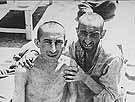
|
|
|

|

|

|

|
|
Click on an image to see a larger, more detailed picture.
|
|
|
|
|
| 1945: Liberation and Rebuilding |

|
pg. 620 |

|
|
|
|
| |
 The Nazis originally created Theresienstadt in Czechoslovakia as a model ghetto/camp complex to dupe the outside world into believing that the regime was not treating Jews badly. But the camp soon became one of the most horrible in Europe. These two skeletal men survived Theresienstadt.
The Nazis originally created Theresienstadt in Czechoslovakia as a model ghetto/camp complex to dupe the outside world into believing that the regime was not treating Jews badly. But the camp soon became one of the most horrible in Europe. These two skeletal men survived Theresienstadt.
Photo: Terezin Memorial Museum/United States Holocaust Memorial Museum Photo Archive
|
 Those camp inmates who did not have poorly fitting footwear had none at all, and prisoners constantly confronted maladies of their feet and legs. This man, a survivor of Theresienstadt, is taking care of the abscesses on his legs and feet. Such debilitating foot problems often led to a prisoner's demise, since inability to work meant death.
Those camp inmates who did not have poorly fitting footwear had none at all, and prisoners constantly confronted maladies of their feet and legs. This man, a survivor of Theresienstadt, is taking care of the abscesses on his legs and feet. Such debilitating foot problems often led to a prisoner's demise, since inability to work meant death.
Photo: Terezin Memorial Museum/United States Holocaust Memorial Museum Photo Archive
|
|
Odessa In the days of confusion after the war, many Nazis--from senior SS officials to concentration-camp guards--escaped justice by fleeing Europe. How war criminals such as Adolf Eichmann, Josef Mengele, and Franz Stangl reached safety in South America remains shrouded in mystery. The name "Odessa" has been used to refer to a secret network of organizations that facilitated the escape of Nazis and furnished them with new identities. Speculation abounds about the leadership and finances of these secret organizations, but no doubt exists that Nazis received help of various kinds, from forged passports to tickets and money, sometimes from those who knew their identities, sometimes from those who were duped. In South America, sympathetic dictators refused requests for extradition, sometimes leaving kidnaping as the only means to bring a Nazi criminal to justice. This was the case with Eichmann, who was seized in Argentina by Israeli secret-service agents and transported to Israel to stand trial.
|
|

|

|

|

|
 May 5, 1945: The U.S. 11th Armored Division liberates the concentration camp at Mauthausen, Austria. 110,000 survivors are found, including 28,000 Jews. Bodies of 10,000 inmates are discovered in a mass grave. In the days following liberation, more than 3000 inmates will die.
May 5, 1945: The U.S. 11th Armored Division liberates the concentration camp at Mauthausen, Austria. 110,000 survivors are found, including 28,000 Jews. Bodies of 10,000 inmates are discovered in a mass grave. In the days following liberation, more than 3000 inmates will die.
|
 May 5, 1945: The camp at Gusen, Austria, near Mauthausen, is liberated by the U.S. Army; 2000 inmates remain alive.
May 5, 1945: The camp at Gusen, Austria, near Mauthausen, is liberated by the U.S. Army; 2000 inmates remain alive.
|
 May 5, 1945: German troops surrender in Norway.
May 5, 1945: German troops surrender in Norway.
|
 May 5, 1945: The presiding bishop of the German-Catholic bishops' conference instructs his priests to say a mass in Hitler's memory.
May 5, 1945: The presiding bishop of the German-Catholic bishops' conference instructs his priests to say a mass in Hitler's memory.
|
 May 5, 1945: The U.S. 71st Infantry Division liberates the camp at Gunskirchen, Austria, where 18,000 inmates remain alive. Hungarian author and journalist Geza Havas, force-marched to the camp from Mauthausen, dies a few hours before the Americans arrive.
May 5, 1945: The U.S. 71st Infantry Division liberates the camp at Gunskirchen, Austria, where 18,000 inmates remain alive. Hungarian author and journalist Geza Havas, force-marched to the camp from Mauthausen, dies a few hours before the Americans arrive.
|
|
|
|
|
| 1945: Liberation and Rebuilding |

|
pg. 620 |

|
|
The Holocaust Chronicle
© 2009 Publications International, Ltd.
|
|
